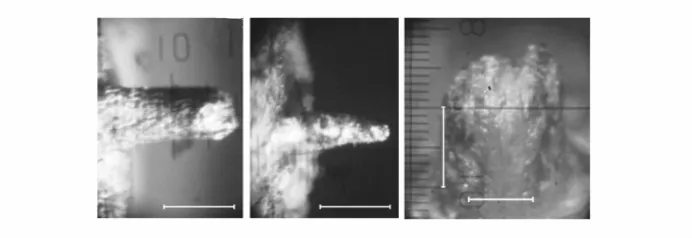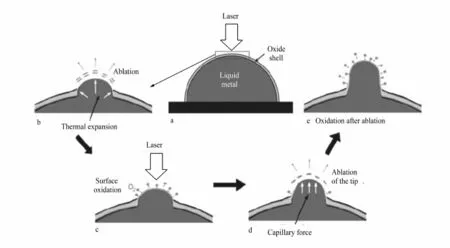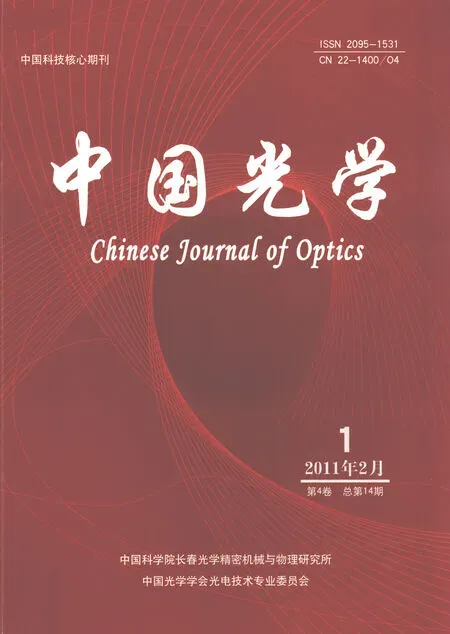纳秒激光烧蚀下液态金属表面微结构的形成
2011-05-13TARASENKOPANCHENKOBULGAKOVASHULEPOVTELMINOV李殿军张来明谢冀江
TARASENKO V F,PANCHENKO A N,BULGAKOVA N M,SHULEPOV M A,TEL′MINOV A E,李殿军,张来明,姜 可,谢冀江
纳秒激光烧蚀下液态金属表面微结构的形成
TARASENKO V F1,PANCHENKO A N1,BULGAKOVA N M3,SHULEPOV M A1,TEL′MINOV A E1,李殿军2,张来明2,姜 可2,谢冀江2
(1.俄罗斯科学院西伯利亚分院强电流研究所,托木斯克634055;2.中国科学院长春光学精密机械与物理研究所,激光与物质相互作用国家重点实验室,吉林长春130033;3.俄罗斯西伯利亚分院热物理研究所,新西伯利亚630090)
首次发现了在不同保护气体及多脉冲U V-I R激光的照射下,液态金属的微型突起和微结构的形成。测量表明,针对不同的金属和保护气,这种结构的单脉冲生成速率可达(5~2 0)μ m/p u l s e,形成了长度为1~2m m,直径约为焦点两倍的单个微型突起。最后,介绍了控制微结构形状的可能性,并讨论了它们的应用潜力。
液态金属;表面;微结构;纳秒激光烧蚀
1 Introduction
At present,the investigation of powerful laser pulse action on different substances are widely performed and various technology applications based on laser ablation are developed[1].It was reported inRef. [2-6]thatmicro-nanostructures can be formed on the solid surface after laser action,mechanisms of the structure formation are listed in Ref.[4].However,atall variety of laser action variants only insufficientattention was given to ablation of liquidmetals in Ref.[7-9].The ablation threshold and dynamics of liquid and solid Ga and In were compared[7-9],the laser ablation of melted Sn and Bi and processes on the liquid surfacewere studied[10],and the relaxation time ofmelted surface of Ga,Ga-In alloy and wood metal after laser pulse weremeasured[11].
Here we report a new phenomenon which has been observed for the first time to our knowledge,namely formation ofmicrostructures on multishot ns laser irradiation(IR and UV)of liquid metals in the presence of reactive ambient gases.Instead of the formation of a crater,as takes place under vacuum conditions or in inert gases,a tower-like structure with diameter somewhat exceeding the irradiation spot size grows on the irradiated surface at a rate of 3-20μm per pulse,depending on laser fluence and metal type.
2 Experimental arrangement
The experimental setup is shown schematically in Fig.1.Moltenmetals(Ga,In,Sn Pb alloy,Wood′s metal)were placed in a Gas Chamber(GC)equipped with a heater whose temperature was kept constant during the experiments.The chamber can be pumped down to 1.33 Pa or filled with different gases(air,Ne,N2,SF6,NF3).Metals weremaintained in a liquid state,and their temperature was controlled with a thermocouple.Multishot irradiation(repetition rate in 1-10 Hz)was carried out with several lasers,a Q-switched Nd∶YAG laser[λ=1 064 nm,pulse duration in 2.5 ns at Full-width Half-maximum(FWHM),maximal pulse energy in 0.25 mJ],a nitrogen laser(λ=337 nm,pulse duration in 4.5 ns at FWHM,maximal pulse energy in 0.25 mJ)or excimer KrCl laser(λ=222 nm,pulse duration in 9 ns at FWHM,maximal pulse energy in 2 mJ).The laser beamswere focused by a quartz lens(with focal length of 5 cm)and could couple to the targets horizontally.The irradiation spot diameter on the target surface was typically about0.1 mm,and themaximum power density was 1.4×109W/cm2,0.9×109W/cm2and 1.5× 108W/cm2for the Nd∶YAG,N2and KrCl lasers,respectively.

Fig.1 Schematic diagram of experimental setup
The state of the target surfacewas analyzed with a digital camera or a high-speed CCD camera(SensisCam)in front of which Light Filters(LF)were placed to ensure a linear operation regime.The target surface was illuminated by a Flash Lamp(FL),and photographs were taken after each laser shot. The temporal evolution of the laser induced plume emission was measured by using a photocell and a TDS-3034 digital oscilloscope.The surface layer structure was analyzed with a Scanning Electron Microscope(SEM)with the type of PHILIPS SEM-515.
3 Experimental results
Fig.2 presents the microstructure structures grown bymultishot irradiation(Nd∶YAG laser,200 pulses,fluence F0=3.2 J/cm2)of themolten targets.The initial temperature T0of gallium(30℃)was only slightly above its melting point(Tm=29.76℃),while the other targetswere heated to about250℃. Under vacuum conditions at the applied fluence,a luminous laser plasma is observed above the irradiated surfaces,indicating a strong ablation regime, and a crater is formed,which is healed within severalms[11].In air at 1 bar,a bright plasma plume is also seen.However,instead of a crater,a towerlike structure is seen to grow on the irradiated surface as illustrated in Fig.2.The microstructure diameters are typically twice the size of the irradiation spot.The average growth rate Vgis estimated to be 3 -5μm per pulse for allmetals except the Sn Pb alloy,which grew at a rate almost three times slower. It should also be noted that the Sn Pbmicrotower diameters are approximately 1.5 times larger than those of the othermetals.

Fig.2 Microstructures grown in air by 200 pulses of Nd∶YAG laser on Ga(a),In(b),Wood′smetal(c),and Sn Pb alloy(d)liquid targets.The initial temperature T0 is30℃ for gallium and~250℃ for othermetals.F0 is 3.2 J/cm2 and a scale bar is 500μm.

Fig.3 Microstructures on liquid Sn Pb alloy(a)and Ga(b),(c)obtained with N2(a),(b)and KrCl-laser(c)in air. The numbers of pulses are 350(a),450(b),and 75(c).The initial temperature is450℃ for Sn Pb alloy and 30℃for gallium.Laser fluence is3.2 J/cm2(a)and 1 J/cm2(b),(c).Scale bars is1 mm(a),(b)and 0.25 mm(c).
Increasing the liquid target temperature results in a higher growth rate as demonstrated in Fig.3. Themicrotower structures on Sn Pb alloy and gallium which were grown in air with the use of the N2-laser have the same lengths.This was achieved by increasing the Sn Pb target temperature to 450℃while keeping the gallium targetat30℃.Note that,although themicrostructure growth on Ga requires a larger number of pulses,the laser fluence is considerably smaller compared to thatneeded for the Sn Pb microstructure growth.Fig.3 shows that,by varying the irradiation parameters,one can easily control the growth process of these unusual structures.However,under similar irradiation conditions,the Sn Pb microstructureswere found to grow less readily compared to the other studied metals.It should bementioned thatwe have not found a strong difference in using Nd∶YAG or N2lasers formicrostructure formation.The only differences are in the higher reflection coefficient and the higher plasma screening effect on IR radiation that requires a higher value of applied laser fluence(or a larger number of pulses)formicrotower formation of the same length,compared to UV laser light.
Maximal growth rate in our experimentwas observed in SF6.In air,the rate was 2-3 times lower,when the rate falls by one order ofmagnitude in N2.This means that the rate of microstructure formation is controlled by the chemical reactivity of the ambient gas.
In the case of KrCl laser,the structure is formed at specific radiation power of about 5 times lower due to relatively high radiation divergency than in the case of Nd∶YAG and N2lasers.The growth rate about 7μm/pulse is close to that obtained with lasers at1 054 and 337 nm.
The SEM analysis by 30 keV electrons of the microstructure shows that the surface of the molten target is highly oxidized outside the irradiation zone,and themicrostructurewalls are also covered by oxidized metals with the Me∶O ratio being very close to 1∶1.However,themicrostructure tip is oxygen-deficient,compared to the microstructure walls and the nonirradiated target sites.As the estimated penetration depth for 30 keV electrons is slightly less than 2 μm,onemay conclude that either the oxide layer on themicrostructure tip ismuch thinner than 2μm or the oxide and metal are mixed due to complicated hydrodynamicswithin the laser irradiation spot during the ablation process.This allows to conclude that themicrostructure is a capillary with walls from metal oxide(nitride,fluoride)filled with liquid metal.
4 Theoretical analysis and discussion
As the process ofmicrostructure formation is clearly connected with the regime where liquid metal ablation occurs,we have applied a thermalmodel in order to evaluate the heating and ablation depths resulting from single pulse irradiation and the corresponding temperature profiles.The thermalmodel details are described in the Ref.[12,13].According to modeling for3.2 J/cm2,the irradiated Ga surface is heated up to 4 800 K that causes ablation of a layer with the thickness about 5 nm.However,such a high temperature level exists only for a few nanosecondswhereupon the heat is conducted towards the target depth.A layer of at least1μm thickness reaches the temperature on the order of 1 000 K.Taking into account the linear expansion coefficient of molten gallium(1.8×10-5K-1),we evaluate the linear expansion to be about 20 nm,that is,larger than the ablation depth.Hence,immediately after an ablation event,a bump of liquid metal should be formed instead of a crater.Then the surfaces of the generated microbump experience rapid chemical reaction with ambient gas and“chemical envelope”from oxide(nitride,fluoride,etc.,depending on gas environment)is formed.
Note thatheating of the oxide layer covering the metal surface is not considered in themodeling.The existence of such a layer can also influence the ablation dynamics.For laserwavelengths applied here to ablate liquid metals,the mostmetal nonmetal compounds are either transparent or have much smaller absorption coefficients compared to metallic sol-ids[14].As a result,the laser pulse couples to the metal surface through a thin covering oxide(nitride,fluoride,etc.)film.Due to the contactwith the laser-heated metal,the outer film will heatup and will either thermally decompose when reaching the decomposition temperature or,with higher probability,will fracture under the high thermal stress[15].
Thus,we can propose a scenario ofmicrostructure formation which is presented in Fig.4.

Fig.4 Schematic representation of themicrostructure growth process on laser ablation of liquid metals in reactive atmosphere(air as an example).For explanation,see text.
A liquid metal drop subjected to surface oxidation is covered by a solid oxide layer which poorly absorbs laser irradiation.A laser pulse couples to themetal surface through the oxide layer(see Fig.4(a)).
Themetal layer,heated by laser radiation,expands and partially vaporizes(up to few nm,see Fig.4(c))causing fracturing of the oxide layer(see Fig.4(b)).The ablation products(metal vapor and oxide debris)expand into the atmosphere.The hot liquid metal,due to thermal expansion,protrudes through the hole produced in the oxide shell by the laser.
During the time interval between two subsequent pulses,the surface of the protruded metal is subjected to oxidation(see Fig.4(c)).
The next laser pulse couples to the top part of the formed bump and ablates a small amount ofmetal.If a thin oxide film has been formed between the pulses,it is partially fractured in the top site,and its debris is carried away with the laser ablation plume(see Fig.4(d)).As the bump top is now bare of oxide while its side walls are preserved,capillary forces drive the liquid metal up through the formed oxide tube in the irradiation geometry as in Fig.4.If the laser pulse couples to the target in the horizontal geometry is as shown in Fig.1,the liquid metal is squeezed out through the oxide tube by the pressure within the droplet.Note,that in both irradiation geometries the microstructure growth has been observed in the present experiments.
When irradiation terminates,the produced microstructure is covered by an oxide layer(see Fig.4(e)).
According to the described scenario,the rates of chemical reactions on the surface play a crucialrole for microstructure formation.Here we discuss themicrostructure growth through the surface oxidation,assuming that the proposed scenario is also valid for other reactive atmospheres which can create a rigid skeleton on the liquid metal surface.The oxidation process proceeds due to diffusion ofmetal cations through the growing oxide layer to the sample surface while the oxygen anions diffuse in the opposite direction.Thus,one can expect that a partial oxidation on the tip of a growing microstructure occurs during the time interval between the subsequent laser pulses.Each following laser pulse unseals the top partof themicrostructure,thus allowing themolten metal to flow out from the melt volume through the oxide tube under the action of either capillary forces or the pressure ofmolten material,depending on the irradiation geometry.
5 Conclusion
We have presented a new phenomenon,formation of microstructures,on multishot laser irradiation in the UV-IR spectral ranges of a number of liquid metals(Ga,In,Sn Pb alloy,Wood′s metal)in reactive ambient gases.To reveal the conditions in the laser irradiated zone,thermal modeling was performed,the results ofwhich furnished the clue to understanding the importance of a number of the process parameters.The microstructure formation is shown to be governed by interplay between different processes,including ablation,thermal expansion,temperature variations of viscosity,surface tension,thermal stresses,and capillary effects.The most important factor is surface chemistry.The rates of chemical reactions on the liquid metal surface control both the microstructure growth rate and stability of the formed coatings on themicrostructure walls.
It should be noted that we have touched only the basic mechanisms of microstructure formation and some ways for growth control.It can be expected that microstructure length,radius,and growth rate can be regulated by changing the irradiation spot size,pulse duration(down to femtosecond laser pulses),ambient gas type,pulse repetition rate,etc.The described microstructures can open ways for a number of possible applications,among which we can conceive ofmanufacturing a variety of microparts, moulds, and decorations. Another application may be in studying the chemistry of surface reactions under strongly non-equilibrium conditions.As an example,we can conjecture that the microcones growth observed[16,17]is governed by similar processes to those responsible formicrostructure formation.
[1]PHIPPS C.Laser Ablation and its Applications[M].Berlin/Heidelberg:Springer Series in Optical Sciences,Springer,2007,129:586.
[2]VORONOV V V,DOLGAEV S I,LAVRISHCHEV SV,etal..Formation of conicmicrostructures upon pulsed laser evaporation of solids[J].Quant.Electronics.,2000,30(8):710.
[3]DOLGAEV S I,KIRICHENKO N A,SIMAKIN A V,et al..Microstructures produced on spatially confined substrates exposed to repetitively pulsed laser radiation[J].Quant.Electronics.,2007,37(7):645.
[4]KOLASINSKIK W.Catalytic growth of nanowires:vapor liquid solid,vapor solid solid,solution liquid solid and solid liquid solid growth[J].Current Opinion in Solid State and Materials Sci.,2007,11:76.
[5]PESTOV Yu I,MAKIN V S.Laser-induces formation of conicalbumps on the surface of superrefractorymetals[J]J.Opt. Technol.,2008,75:371.
[6]MOENING JP,THANAWALA SS,GEORGIEV D G.Formation ofmicrobumps and high-aspect-ratio protrusions on gold films by localized nanosecond pulsed laser irradiation[J].Appl Phys A,2009,95(3):635.
[7]GÖTZ T,STUKE M.Short-pulse UV laser ablation of solid and liquid metals:indium[J].Appl.Phys.A,1997,64(6):539.
[8]ZERGIOTI I,STUKEM.Short pulse UV laser ablation of solid and liquid gallium[J].Appl.Phys.A,1998,67(4):391.
[9]KISO M,MIZUNO K,SUZUKIJ,et al..Laser ablation of amolten Ga target;comparison of experiments and simulation [J].Appl.Phys.A,2002,74(2):139.
[10]TOTH Z,HOPP B,SMAUSZ T,et al..Excimer laser ablation ofmoltenmetals as followed by ultrafast photography[J]. Appl.Surf.Sci.,1999,138-139:130.
[11]TARASENKO V F,LJUBCHENKO FN,PANCHENKO A N,etal..Dynamics of liquid metal surface under the action of XeCl-laser pulses[J].Publ.Astron.Obs.Belgrade,2008,84:237.
[12]BULGAKOV A V,BULGAKOVA N M.Thermal model of pulsed laser ablation under the conditions of formation and heating of a radiation-absorbing plasma[J].Quantum Electron.,1999,29:433.
[13]BULGAKOVA NM,BULGAKOV A V,BABICH LP.Energy balance of pulsed laser ablation:thermalmodel revised[J]. Appl.Phys.A,2004,79:1323.
[14]PALIK E D.Handbook of Optical Constants of Solids[M].Orlando:Academic Press,1998.
[15]BOVATSEK J,TAMHANKAR A,PATEL R,et al..Effects of pulse duration on the ns-laser pulse induced removal of thin film materials used in photovoltaics[J].SPIE,2009,7201:720116.
[16]ZORBA V,TZANETAKIS P,FOTAKIS C,et al..Silicon electron emitters fabricated by ultraviolet laser pulses[J]. Appl.Phys.Lett.,2006,88:081103.
[17]SKANTZAKISE,ZORBA V,PAPAZAGLOU D G,et al..Ultraviolet laser microstructuring of silicon and the effect of laser pulse duration on the surfacemorphology[J].Appl.Surf.Sci.,2006,252:4462.
Author′s biography:Victor Fedotovich Tarasenko(1946—),male,Professor,Laboratory of Optical Radiation,Institute of High Current Electronics,Siberian Branch of the Russian Academy of Sciences.Hismain research fields are gas discharges with runaway electrons,UV and VUV spontaneous light sources,pulsed lasers on dense gases and applications.E-mail alexei@loi.hcei.tsc.ru
Formation ofm icrostructure on liquid metal surface under nanosecond laser ablation
TARASENKO V F1,PANCHENKO A N1,BULGAKOVA N M3,SHULEPOV M A1,TEL′MINOV A E1,LIDian-jun2,ZHANG Lai-ming2,JIANG Ke2,XIE Ji-jiang2
(1.Institute of High Current Electronics Siberia Branch of the Russian Academy of Sciences,Tomsk 634055;2.State Key Laboratory of Laser Interaction with Matter,Changchun Institute of Optics,Fine Mechanics and Physics,Chinese Academy of Sciences,Changchun 130033,China;3.Institute of Thermophysics Siberia Branch of the Russian Academy of Sciences,Novosibirsk 630090,Russia)
Formations of stablemicro-protrusions and microstructures on the surfaces of liquid metals during multipulse action of a UV-IR laser in different ambient gaseswas discovered for the first time.The rate of the structure formation wasmeasured,which can reach 5-20μm/pulse depending on themetal and ambient gas sort.Singlemicro-protrusions of 1-2 mm in length were formed with the diameter approximately two times greater than the focal spot size.The possibility to control themicrostructure shape was shown and their potential applicationswere also discussed.
liquid metal;surface;microstructure;nanosecond laser ablation
Supported by Russian Foundation for Basic Research Project(No.11-08-00427-a)
TN249
A
1674-2915(2011)01-0046-07
2010-08-11;
2010-10-13
